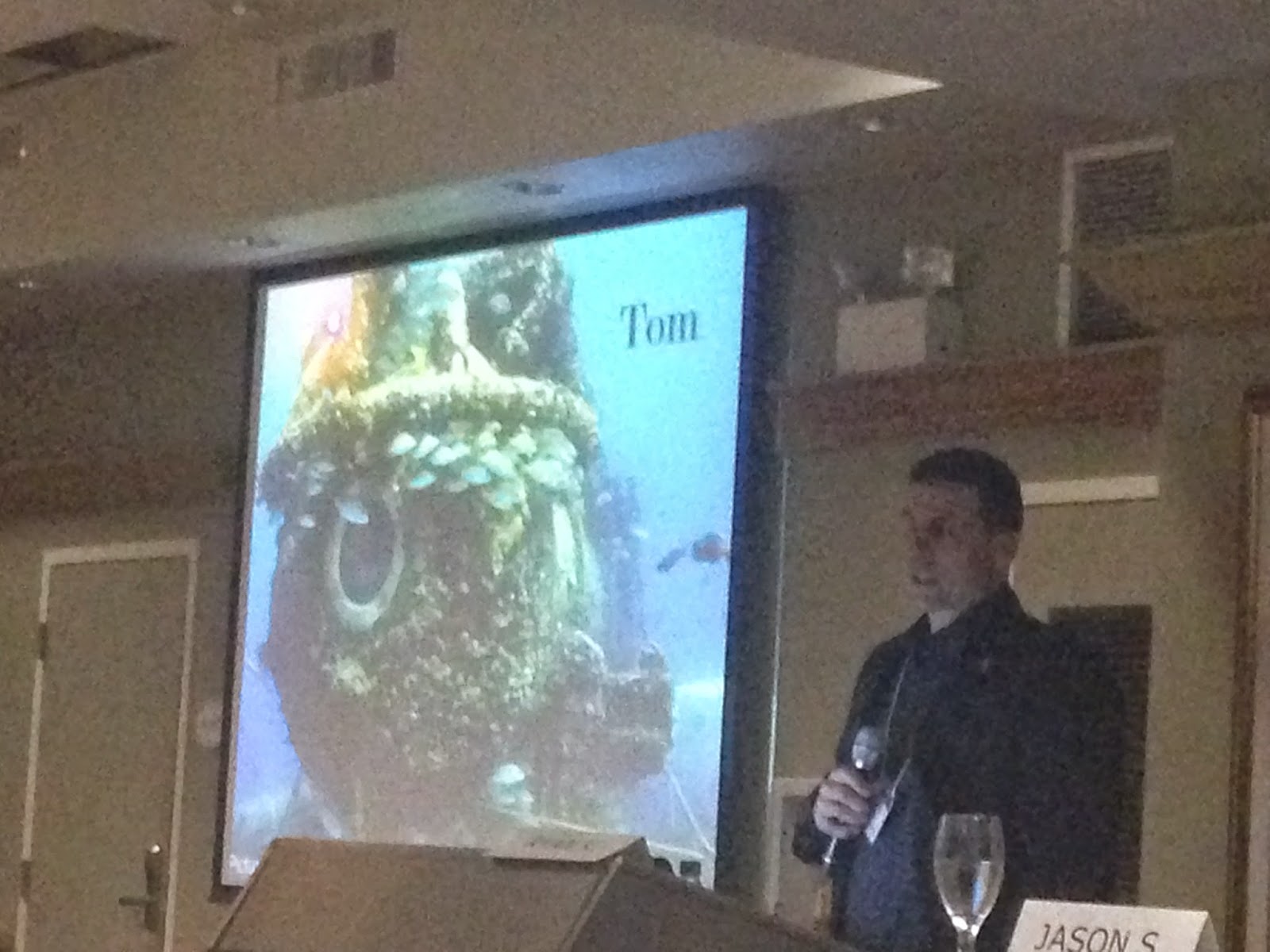Last night I attended Yuri's Night Part
2 in Cocoa Beach in conjunction with the annual Lunar Surface
Applications workshop. Last year I also popped into this workshop for
the Yuri's Night mixer as well. One of these days, I'd like to
actually attend the workshop.
The event kicked off with a mini
social where I hung with some of my space peeps. When a crowd had gathered, they
began pulling names out of a box to win door prizes. I was the first
to win a prize: a Fisher space pen which writes upside down. I also noted a 3D printing display that was showing space shuttle love.
Finally the big event began, a panel
titled Isolated and Dangerous: Analogue Research for Human Space
Exploration. Guest speakers included Jason Shuler of NASA's Swamp
Works, Anne Caraccio of NASA, Tom Potts of Aquarius Reef Base, Ryan
Kobrick of Space Florida (and Yuri's Night), and astronaut Cady
Coleman (STS-73, STS-93, Soyuz TMA-20, Expedition 26/27).
Admittedly, as much as I would love to go to space, I have no interest in being miserable on Earth at analog sites. I would visit any of the analog sites for a day, but to stay for an extended period of time, no thank you. I did a week-long geology field camp with NASA's Lunar Science Institute Meteor Crater Field Camp a few years back which reminded me how much I dislike camping. I'll leave the analog research to those who like to rough it.
Jason (who I previously met when I worked with Phil Metzger a few years back) spoke about his experience
with NASA's Research and Technology Studies (Desert RATS) in 2009. He
described the issues with working in dust environments and within the
pressurized vehicle Lunar Exploration Rover (now the Multi-Mission
Space Exploration Vehicle). Part of his work was developing ways of
easily donning space suits that docked to the vehicle. There is no
substitute for field testing, he said.
Anne spoke about her experience at the
Hawaii Space Exploration Analog and Simulation (HI-SEAS). She spoke
about how her crew adjusted to the analog by implementing a 40 min
delay (sound takes time to travel across distances). They also
limited their power and bandwidth and isolated their habitat. She
noted that the high two-story space in the habitat helped
psychologically with being in a confined space. They performed planned EVAs,
suiting up to go outside. Inside they performed biology and human
factors research.
Tom Potts, the director of Aquarius
Reef Base, emphasized that the base is not just analog, it's an
actual mission with “aquanauts” that is also used by NASA Extreme
Environment Mission Operations (NEEMO). Aquanaut time underwater is
limited to two weeks because of additional nitrogen in their body
leads to saturation diving. ISS astronauts train on Aquarius and
there are Aquarius - ISS video linkups. Research conducted on
Aquarius includes the testing of space EVA equipment and rovers
including a mockup lunar lander and telerobotics/telemedicine.
My friend and fearless Yuri's Night
leader Ryan spoke about his experience Mars Desert Research Station
(MDRS) in 2007 at Haughton impact crater in a very remote area of the
arctic. His crew was from different cultures. They conducted space
suit testing, human factors research, and a food study to increase
enjoyment. For a month they worked on Martian time which is 23 hours
37 minutes per day. They conducted field work and sterilized their
drill each time they took a sample. They also conducted a water use
study to conserve water.
Astronaut Cady Coleman described her
experiences on various analog missions and in the International Space
Station. Everything is an analog, she said. She loved NEEMO except
for using the bathroom surrounded by meddling fish. She lived in
Antarctica for a time, moving tents every week. There, they search for
meteorites and found a thousand of them, including a lunar meteorite.
She spoke about the human piece and how to manage personal space and
personal items. She then spoke about her time on ISS and some of the
science experiments she worked on. Analog missions are to determine
what's hard, what's easy, and what can we learn, such as improve
space suits and equipment. As a petite woman like her, I can relate
when she complained that space suits weren't designed for her build
or size.
The panel Q&A covered a lot of
ground. Crew stress and personality conflicts in confined areas leads
to problems. Everything is magnified because of lack of space. Ryan
described the duct tape protocol: if a crew member went crazy, duct
tape was the protocol. For psychological reasons, it's important to
be able to have have a private conversations with outsiders as an
outlet. Noise privacy is an issue. In an isolated area, you're forced
to meet yourself, even if a stressed version of yourself. Getting
people on the same page to solve problems is essential but also can
be difficult. In the panel's opinion, the main problems remaining to
create an outpost on Moon include logistics, infrastructure, funding,
regolith ISRU technology, risk acceptance (less complaining, more
doing).
Great event, great crowd, and meeting Cady Coleman after the talk make her the 43rd astronaut I've met. I look
forward to Yuri's Night next year.












Great summary ! Thanks
ReplyDeleteSince 1989 I have been working underwater and on board weightless flights to emulate zero-gravity system and payload operations and such flying "analogs" were most precious to us at the European Space Agency to develop ESA and Italian hardware and habitas for the International Space Station.
Best regards
Carlo
www.SpaceLand.it
Excellent, cool work Carlos! The closest I've come to doing that is the scuba tank at the US Space & Rocket Center in Huntsville, Alabama. Would love to do more underwater training someday.
ReplyDelete